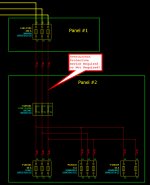Initially my thread got locked asking for clarification on my occupation. I am reposting as I was not able to reply to the question on my related occupation. I am an Electrical Engineering Panel Designer looking for clarification on a NEC code standard.
I have a NEC Code question on the tap rule in which I have read through the NEC240.21 multiple times trying to interpret what is being stated. Looking for some clarification on this forum.
I have an industrial piece of equipment that has multiple panels with one panel (Panel #1) servicing power to other panels on our equipment. In this instance I have 2 panels.
Panel #1 (Main Power Panel)- has 100Amp OCPD
This 100A OCPD is feeding another Panel (Panel #2) that has a Power Distribution Block on it. The conductors are sized appropriately based on the OCPD (100A) feeding this Power distribution block.
Is it a requirement that this panel (Panel #2) have a OCPD prior to the Power Distribution Block? Does the length of the conductors from Panel #1 to Panel #2 also having any outcome in determining the requirement?
Thanks in advance for your review.
I have a NEC Code question on the tap rule in which I have read through the NEC240.21 multiple times trying to interpret what is being stated. Looking for some clarification on this forum.
I have an industrial piece of equipment that has multiple panels with one panel (Panel #1) servicing power to other panels on our equipment. In this instance I have 2 panels.
Panel #1 (Main Power Panel)- has 100Amp OCPD
This 100A OCPD is feeding another Panel (Panel #2) that has a Power Distribution Block on it. The conductors are sized appropriately based on the OCPD (100A) feeding this Power distribution block.
Is it a requirement that this panel (Panel #2) have a OCPD prior to the Power Distribution Block? Does the length of the conductors from Panel #1 to Panel #2 also having any outcome in determining the requirement?
Thanks in advance for your review.


